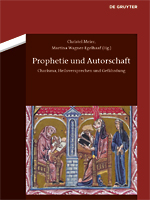Prophethood and Authorship

The prophet as author is a prominent figure in European literature and art from antiquity to our present time. However, this figure has been widely neglected in the intensive debates on authorship of the past decades. Two types formed the picture of prophetic authorship: on the one hand, the prophet of the Old Testament that was established first as an authority and then also as an author in the Jewish scriptural tradition (such as Moses, David, the four major and the twelve minor prophets), and on the other hand, the inspired and enthusiastic poet as a seer (vates) from Plato up until pagan late antiquity.
The volume analyses these models of the divinely inspired and legitimized author in their specific contextual versions and changing functions. It aims at an interdisciplinary comparison in order to describe precisely the different authorial roles in diverse religious and political communities and their scriptural production. Especially in times of crises and revolutions, prophetical charisma claimed to provide critical analysis of the present situation, an interpretation of the future and the promise of salvation. The articles collected in this volume examine the ways in which prophetical speech was granted authority in a twofold meaning of authorship, the specific hermeneutics of prophetical writings and reservations against a false prophethood, as well as critical and ironic views on the old prophetical traditions. The articles are authored by renowned scholars from Theology, Classics, Medieval and New Latin Philology, German Philology, Romance Philology, Arabic Philology, Comparative Literature, as well as History.
Literature: Meier, Christel, and Martina Wagner-Egelhaaf (eds.), Prophetie und Autorschaft. Charisma, Heilsversprechen und Gefährdung, Berlin: De Gruyter 2014 (with contributions from Pia Doering, Christel Meier, Bruno Quast, Matthias Schaffrick, Christian Sieg, Sita Steckel, Martina Wagner-Egelhaaf, and Karin Westerwelle).

